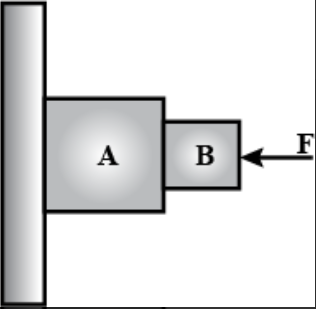Suppose all the surfaces in the previous problem are rough. The direction of friction on B due to A
is upward
is downward
is zero
depends on the masses of A and B
The correct Answer is:A
To determine the direction of friction on block B due to block A when all surfaces are rough, we can follow these steps:
1. Identify the Forces Acting on the Blocks:
- For block A (let's denote its mass as M1), the gravitational force acting downward is M1g.
- For block B (mass M2), the gravitational force acting downward is M2g.
2. Understand the Effect of Friction:
- Friction acts to oppose the relative motion between two surfaces in contact. In this case, we need to analyze the interaction between blocks A and B.
3. Analyze the Motion of Block A:
- Since block A is in contact with a rough surface (the wall), and if it were to slide downward, friction would act to oppose this motion. Therefore, the frictional force on block A due to the wall would act upward.
4. Determine the Direction of Friction on Block B:
- As block A moves downward, it would exert a frictional force on block B. This frictional force would act in the direction that opposes the motion of block A.
- Since block A is moving downward, the frictional force exerted by block A on block B (denoted as FBA) would act upward on block B.
5. Conclusion:
- The direction of the frictional force on block B due to block A is upward. This is to counteract the downward gravitational force acting on block B.
Final Answer:
The direction of friction on B due to A is upward.
---
- For block A (let's denote its mass as M1), the gravitational force acting downward is M1g.
- For block B (mass M2), the gravitational force acting downward is M2g.
- Friction acts to oppose the relative motion between two surfaces in contact. In this case, we need to analyze the interaction between blocks A and B.
- Since block A is in contact with a rough surface (the wall), and if it were to slide downward, friction would act to oppose this motion. Therefore, the frictional force on block A due to the wall would act upward.
- As block A moves downward, it would exert a frictional force on block B. This frictional force would act in the direction that opposes the motion of block A.
- Since block A is moving downward, the frictional force exerted by block A on block B (denoted as FBA) would act upward on block B.
- The direction of the frictional force on block B due to block A is upward. This is to counteract the downward gravitational force acting on block B.
The direction of friction on B due to A is upward.
Topper's Solved these Questions
- FRICTIONBOOK - HC VERMA ENGLISHCHAPTER - FRICTIONEXERCISE - Objective -2
5 Videos
- FRICTIONBOOK - HC VERMA ENGLISHCHAPTER - FRICTIONEXERCISE - Exercises
31 Videos
- FRICTIONBOOK - HC VERMA ENGLISHCHAPTER - FRICTIONEXERCISE - worked out Examples
10 Videos
- FLUID MECHANICSBOOK - HC VERMA ENGLISHCHAPTER - FLUID MECHANICSEXERCISE - All Questions
90 Videos
- GRAVITATIONBOOK - HC VERMA ENGLISHCHAPTER - GRAVITATIONEXERCISE - Question for short Answers
18 Videos
Similar Questions
In the above problem, direction of friction force is
View SolutionConsider the situation shown in figure. The wall is smooth but the surfces of A and B in contact are rough. The friction on B due to A in equilibrium.

View SolutionIn the previous problem. The friction force applied by ground on block B is
View SolutionConsider the situation shown in figure. The wall and the surface of A and B in contact are rough. The friction on A due to .

View Solution"When a person walks on a rough surface the frictional force exerted by the surface on the person is opposite to the direction of his motion". Is it true or false ?
View Solutionsuppose the ends of the coil in the previous problem are connected to a resistane of 100Ω. Neglecting the resistance of the coil, find the heat produced in the circuit in one minute.
View SolutionSuppose the ceiling in the previous problem is that the elevator which is going up with an acceleration of 2.0ms2. Find the elongations.
View SolutionWhen a person walks on a rough surface, the frictional force exerted by surface on the person is opposite to the direction of his motion.
It is the force exerted by the road on the person that causes the motion.
View SolutionA wheel of mass 1.4 kg and radius 0.4 m is mounted on a frictionless, horizontal axle as shown in Fig. 7.2.50. Alight string wrapped around the rim supports a mass of 2 kg. What is the angular acceleration of the wheel and the tangential acceleration of a point on the rim ? Also find the tension in the string.

View SolutionSuppose the block of the previous problem is pushed down the incine witas force of 4N. How far will the block move in the first two seconds after starting from rest? The mass of the block is 4 kg.
View Solution
